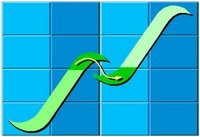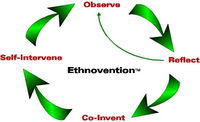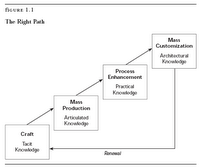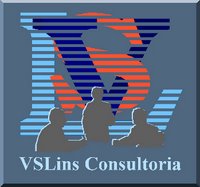1. Speed
The speed of business has changed a lot. We can buy almost anything on the web, and people expect to have the ability to buy things 24/7, 365 days a year because computers hum all the time. E-mail messages fill up overnight even after you deleted all messages the night before. Business is where the buyer and seller meet. The way you do business is changing rapidly. Amazon.com is an example of this rapid movement. Capital moved away from Asia very fast when financial problems started there. The whole economy is moving faster, creating pressure on executives and employees; and decisions have to be made faster than before and globally. The speed mandates a large strategy to convey to the frontline employees on how to bring value, not just lip-service. - KM has to deliver value, not just talk. For example, corporate yellow pages need to be developed, and communities need to move faster. Taxonomy became very important to deal with unstructured knowledge.
- KM can help Executives make better decisions, provide decision support for employees, social network support and taxonomy.
The best we can do for customers is to save them time. Business moving faster means allowing more decisions to be made at the lower level. We need intellectual working data on the desktops. We need to link to strategic imperative, which is customers' imperative
2. E-Commerce
E-Commerce is fuzzying (blurring) the boundaries. It's hard to know where one business ends and another begins. Before the fall of .com business, a survey was taken and showed that 1/3 predicted .com will prevail, 1/3 predicted that the traditional business will prevail, and 1/3 said "don't know." This year the internet commerce created $3 trillion.
E-commerce changes the fundamental ways to do business where sellers and buyers meet. It reduces error and provides real-time market data, which allows better use of the capital.
Dell can see the market real-time, so they can use that knowledge as the power to compete. When you buy something from the web, the seller knows where you came from: Google, Frederick, etc. -
This is tremendous knowledge for business. "Buyer and seller" are like conjoined twins and are interwoven. John Hagel calls this "Fuzzy Boundary of Business." Databases used to be guarded and were never shared with customers. Impact of KM can be seen in how Cisco helps customers configure their network and mediates the knowledge with their customers.
3. King Customer (Growing Power of Customer)
Automobile dealers are now faced with different negotiations with buyers because the buyers have more information about the dealer collected from the web. It became very hard to keep the price, and their profit margin was lowered from 11% to 6%.
Business has been taken over by consumers, such as decreasing telephone rates. Customer Power cannot be changed, but customer knowledge can be worked with. We have to offer customers better experiences. Therefore, Customer Relations Management becomes more important than ever before.
Customers do not like to be manipulated. You don't manage your wife. What you need to do is to make sure what you do is really valuable for customers. We need to identify unique and valuable selling.
CEO needs to ask "Why do people buy from us, not from others?" Three answers, a) cheaper, b) better quality, and c) we are innovative and responsive.
An organization needs to have cohesiveness, and how to be innovative and responsive depends on intellectual capital. We need to use intellectual assets where it matches.
Human capital is important when the talent is important, such as when you go to a certain restaurant because of the talent of the chef. When you go to McDonald's, it is predictive, cheap and fast with set recipes; this is Structural Capital McDonald's has. When you go to a restaurant because the waitresses are very friendly and you feel welcome, then you are going there for the Customer (Social) Capital. When you hire McKinsey as a consultant, you are buying their IQ, the talent - Human Capital.
When you hire Accenture, you are buying their formula, which is Structural Capital. When you are a customer for one bank, you have a long relationship with that bank - Customer (Social) Capital.
Any organization needs to have at the top level, at a minimum, one of 3 Intellectual Capitals - Human, Structural, and Customer. A beer company in Colorado is depending on structural capital and customer/social capital, when truck drivers for that beer company know to which bars to deliver beers and schmooze with workers at the bar. Customer Value proposition implies that you need to map your talent with those values.
4. Low Cost Worrier (Competition)
CEOs are struggling on how to deal with low-cost worriers, like Wal-Mart, Dell, Ameritrade, etc., that provide marginal quality service with low cost. To compete against low-cost worriers is to sell experience, such as Starbucks, to sell continuous innovation, to sell quality services, or become niche player. We need to find the competitive advantage.
5. Uncertainty on Decision Making
Management used to work with predictability since the scientific management started by Frederick Taylor. Then TQM promoted reduction of variances and control, "Execution" always matters.
We believed that people are rational. Now non-linearity and unpredictability are more common in the networked global environment. We talk about futility of forecasting, because you don't know how to plan under this environment where there exists ambiguity of outcome.
The relationship between cause and effect is obscure and the decision making model we used to use is not very helpful. We used to examine, evaluate, review options and decide--different kinds of decisions for different problems; There are four different kinds of problems (environment):
- a) Cause-effect well connected,
- b) Complicated problems,
- c) Complex Systems, and
- d) Chaos.
KM is currently helping with two problem areas. When there is a cause and effect relationship and this relation is knowable, then we can find an expert. KM can facilitate finding the expert. When we have a complicated problem, such as an airplane built by Boeing, if you disassemble the plane, you can re-assemble again because connections are fixed, knowable and predictable. KM can be useful here.
However, with complex systems, when you dissemble it and put it back together, they don't look the same. Different patterns emerge and communities are organic.
For example, an employee goes to another country to work for a year and returns to the same office. He/she will find that the organization is not the same any more. Even though it's the same office, the same people, but they don't use the same approach. We don't know how KM can help here.
Then there is Chaos, where there is no known cause and a random pattern. It's like you are lost on a mountain and are using a wrong map, then you will not be able to find a way out. It is important to know what kind of decision is needed. When you don't know the question, how do we know who needs to know what? It is a fundamental question for KM.
Thomas Stewart "Five Challenges for the Next Five Years"
Extraído de NINETEENTH KNOWLEDGE MANAGEMENT ROUNDTABLE CONVENED ON SEPTEMBER 24, 2004 AT MITRE WASHINGTON.
Leia mais!






